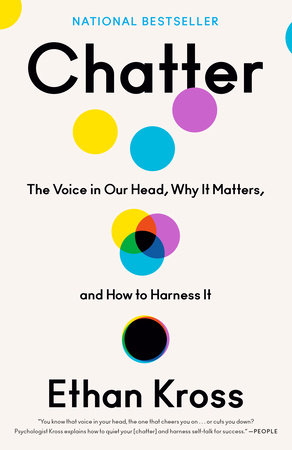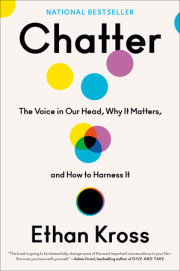Chapter One
Why We Talk to Ourselves
The sidewalks of New York City are superhighways of anonymity. During the day, millions of intent pedestrians stride along the pavement, their faces like masks that betray nothing. The same expressions pervade the parallel world beneath the streets—the subway. People read, look at their phones, and stare off into the great invisible nowhere, their faces disconnected from whatever is going on in their minds.
Of course, the unreadable faces of eight million New Yorkers belie the teeming world on the other side of that blank wall they’ve learned to put up: a hidden “thoughtscape” of rich and active internal conversations, frequently awash with chatter. After all, the inhabitants of New York are nearly as famous for their neuroses as they are for their gruffness. (As a native, I say this with love.) Imagine, then, what we might learn if we could burrow past their masks to eavesdrop on their inner voices. As it happens, that is exactly what the British anthropologist Andrew Irving did over the course of fourteen months beginning in 2010—listened in on the minds of just over a hundred New Yorkers.
While Irving hoped to gain a glimpse into the raw verbal life of the human mind—or rather an audio sample of it--the origin of his study actually had to do with his interest in how we deal with the awareness of death. A professor at the University of Manchester, he had done earlier fieldwork in Africa analyzing the vocalized inner monologues of people diagnosed with HIV/AIDS. Unsurprisingly, their thoughts roiled with the anxiety, uncertainty, and emotional pain produced by their diagnoses.
Now Irving wanted to compare these findings with a group of people who surely had their woes but weren’t necessarily in aggrieved states to begin with. To carry this out, he simply (and bravely!) approached New Yorkers on the street and in parks and cafés, explained his study, and asked if they would be willing to speak their thoughts aloud into a recording device while he filmed them at a distance.
Some days, a handful of people said yes; other days, only one. It was to be expected that most New Yorkers would be too busy or skeptical to agree. Eventually, Irving gathered his one hundred “streams of internally represented speech,” as he described them, in recordings ranging from fifteen minutes to an hour and a half. The recordings obviously don’t provide an all-access backstage pass to the mind, because an element of performance might have come into play for some participants. Even so, they offer an uncommonly candid window into the conversations people have with themselves as they navigate their daily lives.
As was only natural, prosaic concerns occupied space in the minds of everyone in Irving’s study. Many people commented on what they observed on the streets--other pedestrians, drivers, and traffic, for example—as well as on things they needed to do. But existing alongside these unremarkable musings were monologues negotiating a host of personal wounds, distresses, and worries. The narrations often landed on negative content with utterly no transition, like a gaping pothole appearing suddenly on the unspooling road of thought. Take, for example, a woman in Irving’s study named Meredith whose inner conversation pivoted sharply from everyday concerns to matters of literal life and death.
“I wonder if there’s a Staples around here,” Meredith said, before shifting, like an abrupt lane change, to a friend’s recent cancer diagnosis. “You know, I thought she was going to tell me that her cat died.” She crossed the street, then said, “I was prepared to cry about her cat, and then I’m trying not to cry about her. I mean New York without Joan is just . . . I can’t even imagine it.” She started crying. “She’ll probably be fine, though. I love that line about having a 20 percent chance of being cured. And how a friend of hers said, ‘Would you go on a plane that had a 20 percent chance of crashing?’ No, of course not. It was hard to get through, though. She does put up quite a wall of words.”
Meredith seemed to be working through bad news rather than drowning in it. Thoughts about unpleasant emotions aren’t necessarily chatter, and this is a case in point. She didn’t start spiraling. A few minutes later, after crossing another street, her verbal stream circled back to her task at hand: “Now, is there a Staples down there? I think there is.”
While Meredith processed her fear about losing a beloved friend, a man named Tony fixated on another kind of grief: the loss of closeness in a relationship, and perhaps even the relationship itself. Carrying a messenger bag down a sidewalk scattered with pedestrians, he began a self-referential riff of thoughts: “Walk away . . . Look, suck it up. Or move on. Just walk away. I understand the thing about not telling everybody. But I’m not everybody. You two are having a goddamn baby. A phone call would have been good.” The sense of exclusion he felt obviously cut him deeply. He seemed to be poised on a fulcrum of sorts, between a problem in search of a solution and pain that could lead to unproductive wallowing.
“Clear, totally clear. Move forward,” Tony then said. He used language not just to give voice to his emotions but also to search for how best to handle the situation. “The thing is,” he went on, “it could be an out. When they told me they were having a baby, I felt a bit out. I felt a bit pushed out. But now maybe it’s an escape hatch. I was pissed before but, must admit, not so pissed anymore. Now it could work to my advantage.” He released a soft, bitter laugh, then sighed. “I am certain that this is an out . . . I am looking at this positively now . . . I was pissed before. I felt like you two were a family . . . and you two are a family now. And I have an out . . . Walk tall!”
Then there was Laura.
Laura sat in a coffee shop in a restless mood. She was waiting to hear from her boyfriend, who had gone to Boston. The problem was, he was supposed to be back to help her move to a new apartment. She had been waiting for a phone call since the day before. Convinced that her boyfriend had been in a fatal accident of some sort, the night before she sat in front of her computer for four hours, every minute refreshing a keyword search of the words “bus crash.” Yet, as she reminded herself, the eddy of her compulsive negative worrying wasn’t just about a possible bus crash involving her boyfriend. She was in an open relationship with him, even though this wasn’t something she ever desired, and it was turning out to be very hard. “It’s supposed to be open for sexual freedom,” she told herself, “but it’s something that I never really wanted for myself . . . I don’t know where he is . . . He could be anywhere. He could be with another girl.”
While Meredith processed upsetting news with relative equanimity (crying at a friend’s cancer diagnosis is normal) and Tony calmly coached himself to move on, Laura was stuck with repeating negative thoughts. She didn’t know how to proceed. At the same time, her internal monologue dipped back in time, with reflections about the decisions that took her relationship to its current state. For her the past was very present, as was the case for Meredith and Tony. Their unique situations led them to process their experiences differently, but they were all reckoning with things that had already occurred. At the same time, their monologues also projected into the future with questions about what would happen or what they should do. This pattern of hopscotching through time and space in their inner conversations highlights something we have all noticed about our own mind: It is an avid time traveler.
While memory lane can lead us down chatter lane, there’s nothing inherently harmful about returning to the near and distant past or imagining the future. The ability to engage in mental time travel is an exceedingly valuable feature of the human mind. It allows us to make sense of our experiences in ways that other animals can’t, not to mention make plans and prepare for contingencies in the future. Just as we talk with friends about things we have done and things we will do or would like to do, we talk to ourselves about these same things.
Other volunteers in Irving’s experiment also demonstrated preoccupations that jumped around time, braiding together in the patter of the inner voice. For example, while walking across a bridge, an older woman recalled crossing the same bridge with her father as a girl just as a man threw himself off and committed suicide. It was an indelible memory, in part because her father was a professional photographer and snapped a picture of the moment, which ended up in a citywide newspaper. Meanwhile, a man in his mid-thirties crossed the Brooklyn Bridge and thought about all the human labor it took to build it, also telling himself that he would succeed at a new job he was about to start. Another woman, waiting for a late blind date in Washington Square Park, recalled a past boyfriend who cheated on her, which ended up sparking a reverie about her desires for connection and spiritual transcendence. Other participants talked about economic hardships that might await them, while the anxieties of others centered on a looming event from a decade earlier: 9/11.
Copyright © 2021 by Ethan Kross. All rights reserved. No part of this excerpt may be reproduced or reprinted without permission in writing from the publisher.








